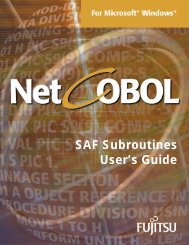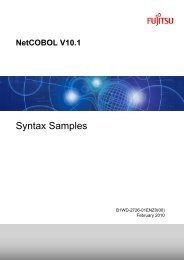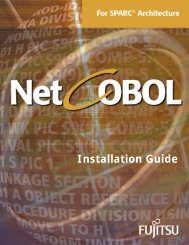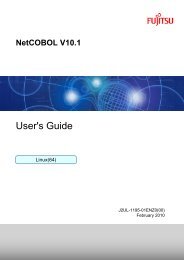NetCOBOL Application Distribution Guide
NetCOBOL Application Distribution Guide
NetCOBOL Application Distribution Guide
Create successful ePaper yourself
Turn your PDF publications into a flip-book with our unique Google optimized e-Paper software.
8 Chapter 1. Introduction<br />
Why a COBOL Runtime?<br />
You may ask, "Why do I need COBOL runtime support? Shouldn't the compiler<br />
convert all my code into just the object code necessary to execute my statements?"<br />
This is a very reasonable question. Particularly for very simple programs, it would<br />
appear to be easy for a compiler to generate a few instructions to implement the<br />
COBOL code.<br />
The answer becomes obvious when you review in more detail the environment in<br />
which programs execute and the tasks a COBOL compiler has to perform.<br />
Consider a program that has a single line in its PROCEDURE DIVISION:<br />
MOVE A TO B<br />
This program still has to be loaded into the Microsoft Windows operating system,<br />
initialized appropriately, started and stopped in the correct manner. It may also have<br />
to carry some other code to respond to messages from the Windows system – even<br />
though the programmer is making no attempt to receive or respond to those<br />
messages. For a single program, it might be reasonable to build all that code into<br />
one object module. However, when you start building 20 or 30 such programs<br />
together, it makes more sense to have all the load, initialize, start, stop etc. code<br />
built into common modules that can be called from each program. So common<br />
environment-related tasks are one reason a COBOL runtime makes sense.<br />
Another reason is that even a simple statement like MOVE A TO B can involve a lot of<br />
work for the COBOL compiler – particularly if A and B have different data<br />
descriptions. There are hundreds of ways each of A and B can be described and<br />
thousands of possible combinations of source and target data types (for example<br />
move a PIC 99V99 COMP item to a PIC 9(10).9 item, or to a PIC 9V9(5) item or ...).<br />
Often it is better to have the compiler invoke common, highly tested routines to<br />
make the transformations, than have the compiler attempt to generate specific code<br />
for every possible move.<br />
Thus, the best way of giving you compact, highly reliable, execution-time support for<br />
your COBOL code is to provide a runtime system that implements all the functions<br />
required by today's COBOL programs.







